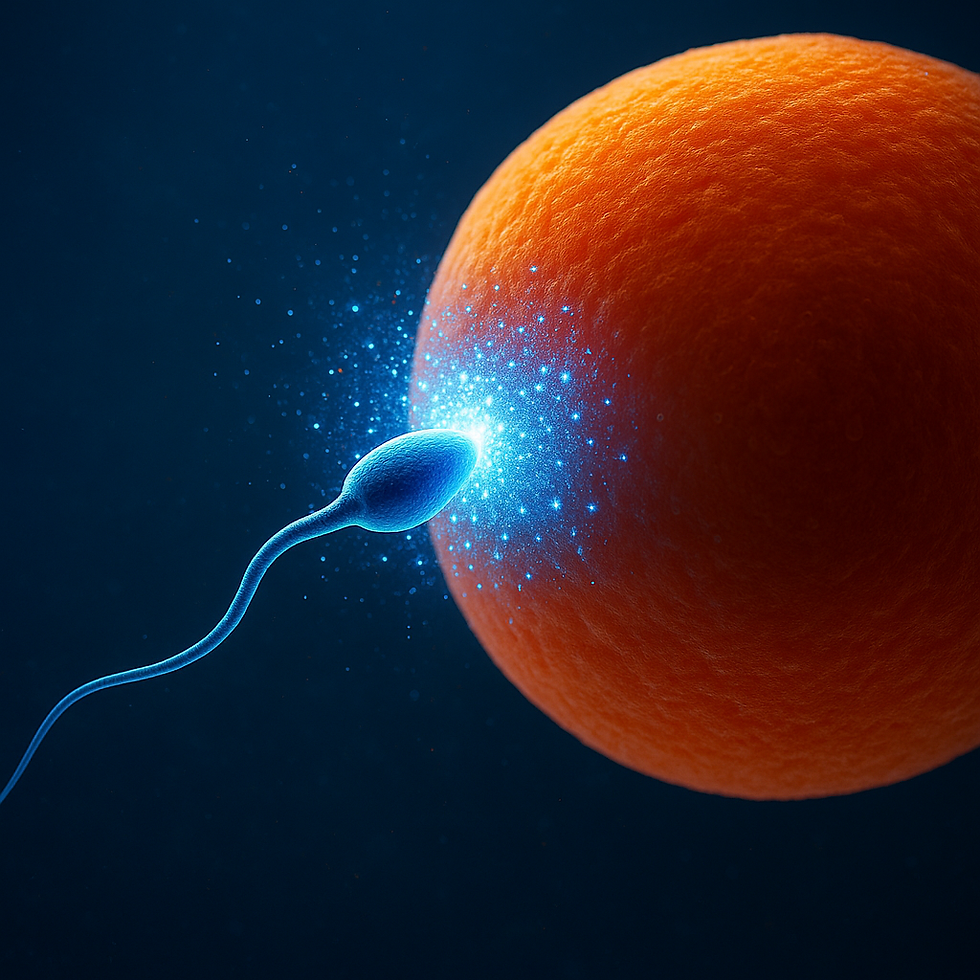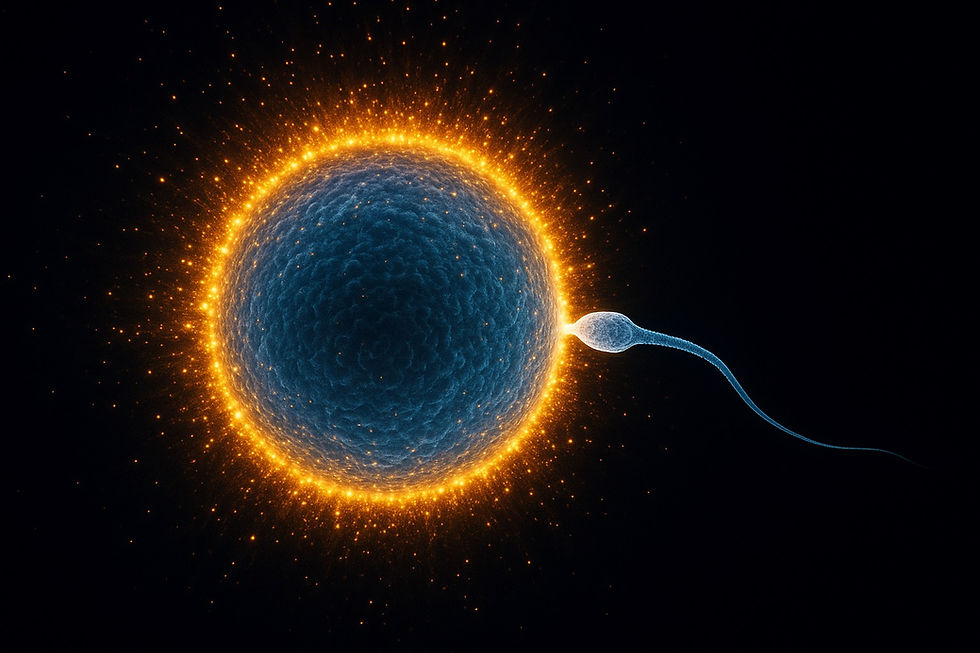The Izumo–Juno Merger: From Ancient Folate Receptors to AI-Revealed Fertilization Secrets
- Courtney Hunt, MD

- Sep 26, 2025
- 3 min read

A Quantum Kiss That Starts Life
Every human life begins with a microscopic encounter between two proteins: IZUMO1, on the sperm, and JUNO, on the egg. This molecular docking isn’t just a handshake—it is the point of no return that sparks calcium oscillations, triggers the zinc spark, and ensures that one sperm, and only one, fertilizes the egg.
For decades, the precise details of this binding remained elusive. We knew these proteins had to recognize one another with exquisite specificity, but exactly how that recognition occurred was hidden from view. It wasn’t until the arrival of AI-powered protein modeling that scientists could finally map the binding interface at atomic resolution.
The Hidden Role of Tryptophan
One of the most striking findings from these AI-driven models was the role of a single amino acid: tryptophan. This conserved residue on JUNO inserts into IZUMO1 like a molecular key, stabilizing the union.
Why does this matter? Tryptophan isn’t just another amino acid. Its aromatic indole ring makes it electron-rich, capable of absorbing light and facilitating electron tunneling. In the context of fertilization, tryptophan isn’t just structural support—it may serve as a quantum mediator, enabling the precision and irreversibility of sperm–egg fusion.
From Folate and Methylation to Fertility
The story deepens when you trace JUNO’s evolutionary lineage. Officially known as FOLR4, JUNO is part of the folate receptor family, a group of proteins that for over a billion years bound folates—vital vitamin B9 derivatives required for DNA synthesis and methylation pathways.
Folate metabolism is the backbone of one-carbon transfers that regulate DNA methylation, histone methylation, and epigenetic control of gene expression. Without methylation, cells cannot divide properly, repair DNA efficiently, or pass on epigenetic marks that guide development.
At some point in mammalian evolution, one folate receptor duplicated and diverged. It gradually lost its ability to bind folate and instead acquired mutations that optimized it for binding IZUMO1. What once ensured access to methyl donors for DNA replication became a molecular guardian of reproduction.
AI evolutionary modeling has now reconstructed this transformation, showing how sequence changes over deep time reshaped FOLR4 from a nutrient transporter into JUNO, the fertilization receptor.
Evolution Written in Proteins
Seen across billions of years, this molecular story follows a clear arc:
• Early life: folates powered nucleotide chemistry and methylation reactions.
• Eukaryotic ancestors: folate receptors evolved to capture and transport B9 compounds for DNA replication and epigenetic stability.
• Mammals: a gene duplication event created FOLR4, which specialized into JUNO, a receptor for IZUMO1.
• Today: a conserved tryptophan residue, spotlighted by AI protein modeling, locks sperm and egg into the first embrace of life, triggering the zinc spark and the methylation-driven reprogramming of the embryo.
Artificial Intelligence as Evolution’s Microscope
Without modern AI-based protein folding tools, the Izumo–Juno binding interface would remain speculative. Deep-learning systems like AlphaFold and related modeling pipelines don’t just predict static structures—they reveal how residues interact, where evolutionary constraints have left signatures, and how small sequence changes drive massive functional shifts.
In this case, AI clarified:
• The structural pocket in JUNO where tryptophan anchors IZUMO1.
• The evolutionary drift from folate-binding to sperm recognition.
• The conserved motifs that safeguard fertilization across mammals.
AI has become a new kind of microscope—not one that sees with photons, but one that reads evolutionary information encoded in sequences to reconstruct molecular history.
Why This Discovery Matters
Understanding the Izumo–Juno merger is more than a curiosity of reproductive biology. It:
• Explains infertility: Disruptions in IZUMO1, JUNO, or the tryptophan interface can prevent fertilization.
• Guides contraception: Blocking this protein–protein interaction could lead to new, non-hormonal contraceptives.
• Illuminates evolution: It demonstrates how ancient metabolic receptors were repurposed for reproduction.
• Connects to methylation and epigenetics: Fertilization sparks a massive wave of DNA demethylation and remethylation, reprogramming the embryo’s genome. Folate biology and JUNO’s evolutionary origin are inseparably tied to this process.
• Links to quantum biology: The aromatic chemistry of tryptophan hints that light and electron dynamics may influence the very first steps of life—including the zinc spark.
Conclusion: Billions of Years in a Single Embrace
The merger of IZUMO1 and JUNO represents a nexus of biology, evolution, and technology. From ancient folate metabolism and methylation to mammalian reproduction, and now to AI-enabled discovery, this story spans billions of years.
Life as we know it begins with this embrace—an embrace illuminated not only by biology but by artificial intelligence, which now allows us to glimpse the hidden choreography of the molecules that make us possible.




Comments